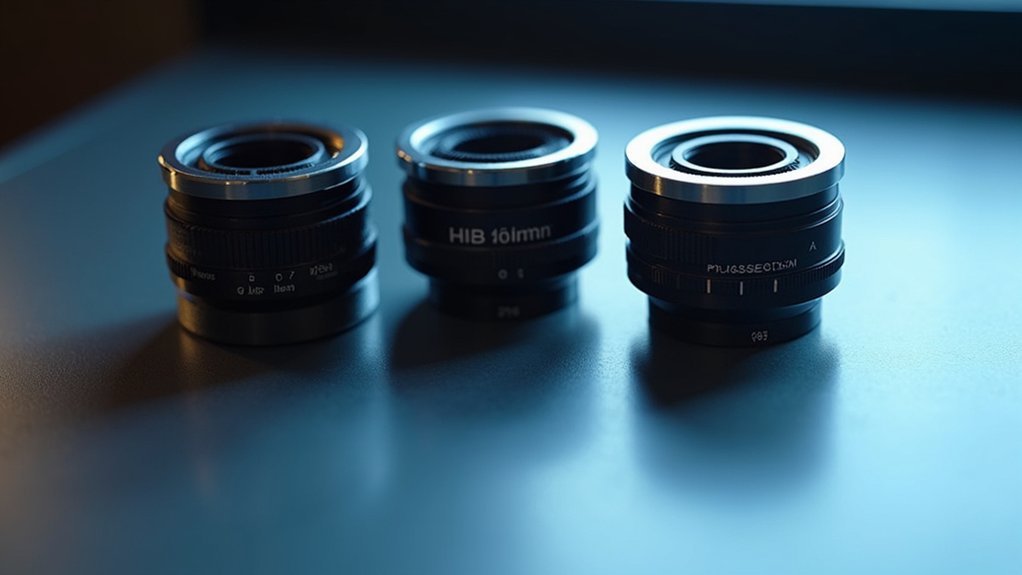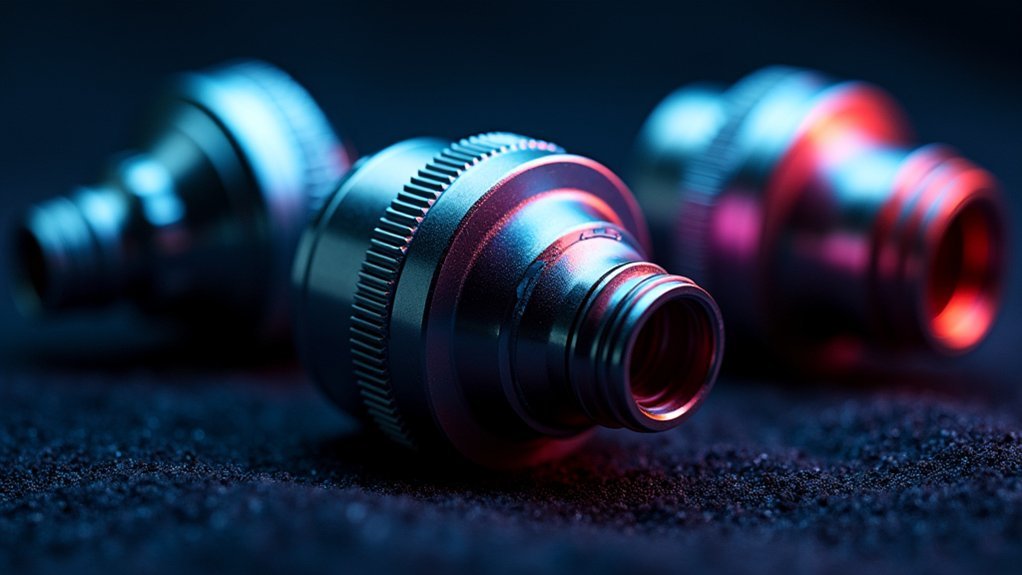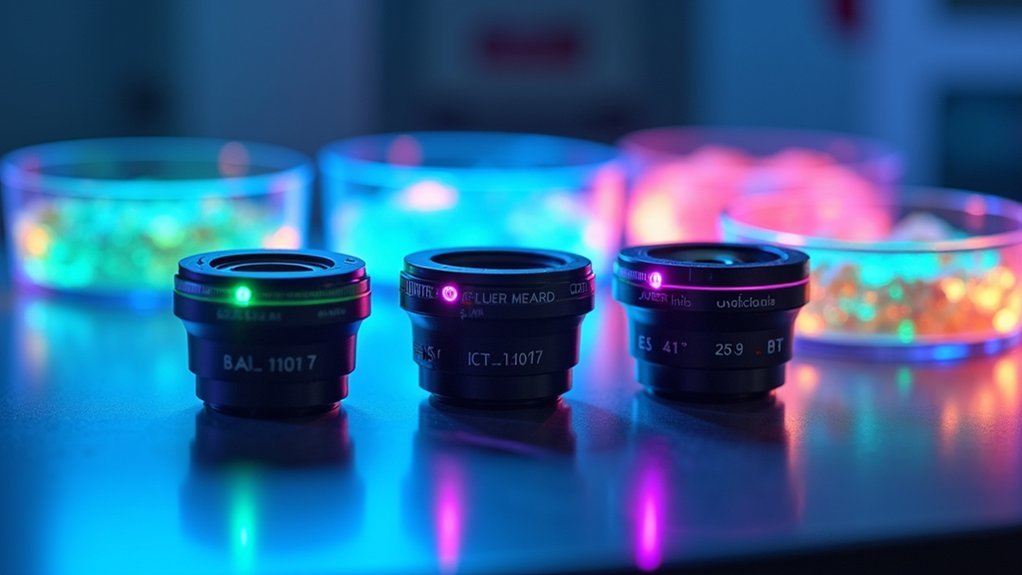The top three fluorescence camera adapters for scientific imaging include high-performance low-light adapters with EMCCD technology and cooling systems, multi-wavelength optimized adapters with specialized filter sets for multiple fluorophores, and precision optical couplings with C-mount compatibility for distortion-free connections. You’ll benefit from monochrome sensors for superior quantum efficiency and binning capabilities that boost signal-to-noise ratios. Discover how these critical components can transform your fluorescence imaging results and research quality.
High-Performance Low-Light Camera Adapters for Enhanced Fluorescence Detection

When capturing the faintest fluorescence signals becomes critical to your research, high-performance low-light camera adapters offer the sensitivity required for breakthrough imaging. EMCCD technology greatly amplifies electrons before reading, revolutionizing your fluorescence microscopy by detecting signals that would otherwise be lost in read noise.
You’ll find that monochrome cameras deliver superior quantum efficiency compared to color alternatives, making them essential for weak fluorescence detection.
To further enhance your image quality, look for adapters with integrated cooling systems like Peltier technology, which minimize dark noise during extended exposure times.
Cooling systems are non-negotiable for serious low-light imaging, reducing thermal noise and preserving critical fluorescence data.
Many adapters also support binning capabilities, allowing you to combine adjacent pixels to boost signal-to-noise ratio in challenging low-light conditions. This feature, combined with high dynamic range, guarantees you’ll capture both dim signals and bright details with remarkable clarity.
Multi-Wavelength Optimized Adapters for Specialized Fluorophore Imaging
Scientists conducting multi-target experiments will find multi-wavelength optimized adapters indispensable for their research workflow.
These camera adapters feature advanced filter sets specifically designed to match the excitation and emission profiles of diverse fluorophores, enabling you to capture multiple targets simultaneously without constant filter swapping.
The specialized optical coatings markedly boost light transmission efficiency, maximizing fluorescence signal detection even in challenging low-light conditions.
You’ll appreciate the flexibility these adapters offer—they’re compatible with both monochrome cameras and color systems, letting you select the ideal configuration for your specific research needs.
Whether you’re performing standard fluorescence imaging, confocal microscopy, or live-cell experiments, multi-wavelength optimized adapters provide the versatility and precision required for cutting-edge microscopy techniques in modern scientific investigation.
Precision Optical Couplings for Microscope-to-Camera Integration

Precision optical couplings represent the critical bridge between your advanced microscope systems and high-resolution cameras.
These adapters—typically C-mount with 1″ diameter and 32 threads per inch—ensure secure connections that maximize light transmission for superior fluorescence imaging results.
When selecting adapters, you’ll need to prioritize appropriate adapter magnification to avoid vignetting. High-quality optics from manufacturers like SPOT Imaging dramatically reduce distortion and enhance image clarity, ensuring your microscope cameras capture accurate specimen representations.
For specialized applications, consider ultra-wide field of view adapters that maximize visible area without compromising resolution.
These precision components are particularly valuable in fluorescence imaging, where even minor optical imperfections can greatly impact data quality.
Remember that the right coupling doesn’t just connect equipment—it transforms your microscope’s capabilities into exceptional digital output.
Frequently Asked Questions
What Is the Best Camera for Fluorescence Microscopy?
For fluorescence microscopy, you’ll find monochrome EMCCD or sCMOS cameras are ideal. They’ll give you superior sensitivity with high quantum efficiency and low noise—crucial advantages when you’re capturing faint fluorescence signals.
What Type of Adapter Is Useful for Attaching Steel Cameras to the Microscope?
You’ll need C-mount adapters for attaching steel cameras to microscopes. These have 1″ diameter threads with 32 threads per inch and maintain the essential 17.526mm flange distance from your camera’s sensor plane.
What Are the Three Basic Types of Fluorescence Microscopy and Recent Improvement?
You’ll find three basic types of fluorescence microscopy: widefield, confocal, and TIRF. Recent improvements include enhanced CMOS sensors with higher quantum efficiency and reduced read noise for better low-light imaging performance.
What Are the Disadvantages of Fluorescence Imaging?
You’ll find fluorescence imaging has key drawbacks: photobleaching degrades dyes over time, autofluorescence from tissues interferes with signals, sensitivity to ambient light complicates imaging, equipment is expensive, and precise alignment requires technical expertise.
In Summary
You’ll find that investing in the right fluorescence camera adapter transforms your scientific imaging capabilities. Whether you need the sensitivity of high-performance low-light models, the versatility of multi-wavelength enhanced adapters, or the precision of specialized optical couplings, your choice directly impacts image quality and data reliability. Select the adapter that aligns with your specific fluorophores and imaging requirements for best results.





Leave a Reply